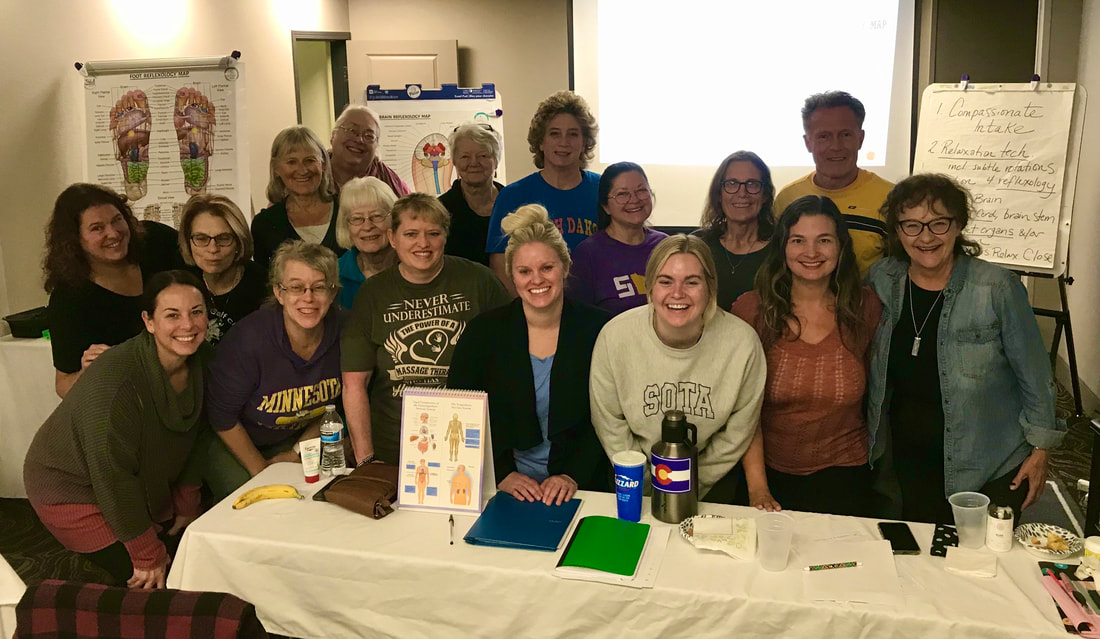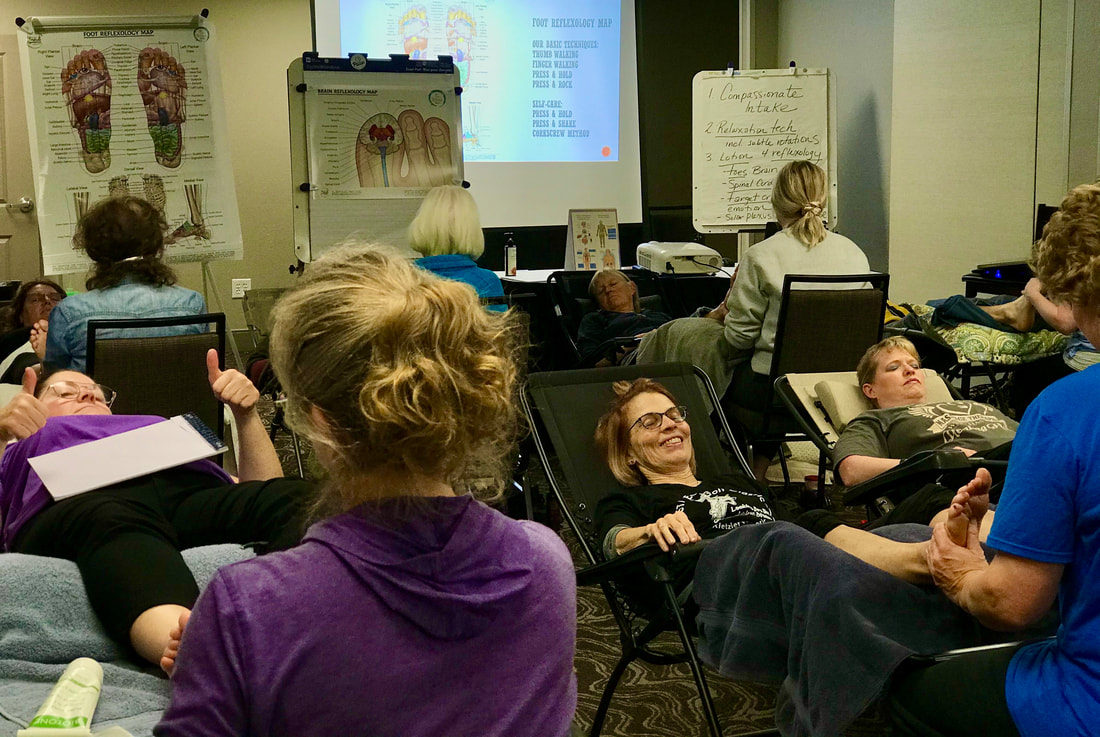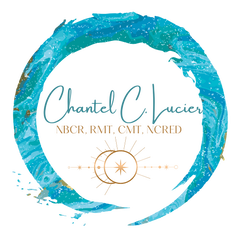|
Anxiety can affect the way we move through life, from the most basic to the more critical aspects of our existence. In our class, we looked at what we can do for ourselves, our families, and our clients who suffer from anxiety. for those of you who were unable to join live, here is the recording. We discussed:
• What anxiety is • How it manifests in us? • What causes it? What triggers anxiety or an anxiety attack? • What parts of the brain are involved in anxiety • What can be done to hold space for anxiety within us to lessen or subside? Self-Care Tools you will learn in this video: • Pranayama (3 ways): 1. The Breath Square 2. Elongating the Exhale 3. Accentuating the Exhale • Reflexology: Brainstem, Thalamus. Amygdala • Prevent, Prepare, Pause, and Pray • Anjali Mudra • Vayu Mudra • Universal Position in Reiki Chantel is not a doctor and does not dispense medical advice. Nor does she diagnose, prognose, or prescribe. The holistic tools taught are not substitutes for medical care. Consult your physician in all matters regarding your health.
0 Comments
I have had quite a long-standing workaholic mindset. In the past, that imbalance of over-production and little sleep often governed my decisions to control energy states with substances and behaviors. We see it all the time—a gravitation toward “just one more cup of coffee” to get us through.
Even when I wasn’t having to be or do anything, I was “on.” There has, however, been a profound shift over the years, especially with the reclusion that ensued in2020. I personally have become more aware of how necessary conserving and mindfully directing my energy is to my health and well-being. Simple tools like moving breath, holding a mudra for a few minutes, going for a walk, or giving myself self-care hand reflexology during breaks are just some of the methodsI’ve employed that have shifted so much within and around me. In this class, you will learn self-care tools to help balance and regulate your energy levels, paying particular attention to finding the flow in and out of so-called “on” and “off” states. What you will learn: 1. Meditation with Chandra Kriya Mudra. 2. Four Directional TaoistExercises. 3. Hand reflexology for the HPA Axis. 4. To quiet yourself, settle, and ask, “what do I need right now.” 5. Know thyself and honor/accept where you are. In moments of imbalance, repeat #4. Chantel is not a doctor and does not dispense medical advice. Nor does she diagnose, prognose, or prescribe. The holistic tools taught are not substitutes for medical care. Consult your physician in all matters regarding your health. #diy, #selfcare, #reflexology, #holistichealth, #holisticselfcare, #energywork, #reikimaster, #reflexologyteacher, #diy, #reikimasterteacher, #reiki, #reflexologist, #mudras, #mudra, #meditation, #serenity, #peace,#balance, #energy, #hpaaxis, #handreflexology, #acceptance I am back from Fargo,ND. I taught to a wonderful group of practitioners (IN PERSON!) a full weekend class on Reflexology for Trauma and Addiction. I am filled with so much gratitude, as every time I teach I, too, learn so much.
A conversation about what we do to invite in serenity, plus self-care tools, rituals, mudras, and meditations to support our journey towards greater tranquility and peace of mind.
What you will learn: 1. Five Element Meditation 2. Kairomancy/Bibliomancy (Thank you, Robert Moss!) 3. Purna Gyan Mudra 4. Abhaya Mudra 5. Rituals for Peace Chantel is not a doctor and does not dispense medical advice. Nor does she diagnose, prognose, or prescribe. The holistic tools taught are not substitutes for medical care. Consult your physician in all matters regarding your health. #selfcare, #reflexology, #holistichealth, #holisticselfcare, #energywork, #reikimaster, #reflexologyteacher, #diy, #reikimasterteacher, #reiki, #reflexologist, #mudras, #mudra, #meditation, #serenity, #peace I am so happy to announce my posters for foot reflexology, spinal nerve chart in chakra colors, and my brain reflexology map are now available... from stickers to posters! In The Art of Power, Thich Nhat Hanh writes, “You don't need to be accepted by others. You need to accept yourself.” Sounds easy enough, but why is it so very difficult?
It is part of our nature to strive and want ourselves and others to be better, brighter, and well… just different. I’ve taught many classes on both pain and our (almost) knee-jerk reaction to rid ourselves of that pain at any cost. How would life—and our experience of it—feel different if we accepted the reality of what was happening within and around us? What if we could accept where we were emotionally, mentally, intellectually, financially, etc.? This is not to say we are ignoring or condoning something that is harmful to ourselves or others. Rather, it means that we choose to accept whatever is—and to act in a way that honors our best self. This moves us into a place where the acceptance itself transforms our experience into one of peace rather than fear, resistance, or dread. And when physical or emotional pain arises, simply say, “I accept.” “I accept you, thought,” “I accept you, pain”, and I accept you—you! I believe acceptance is our first step in healing everything that comes after a difficult situation, feeling, or condition. In this class, we will learn which steps to take to begin the process of accepting ourselves, others, and whatever situation life throws our way. Specifically, we will learn the self-care tools that can help us make the leap from wanting to ignore, detach, be cruel, or push away a state, person, or experience toward wanting to meet the same state, person, or experience with humility, compassion, and love. Surprisingly, genetics is not the only reason we may experience hair loss. There are multitudinous beliefs regarding the who, what, where, when, and why of alopecia (the medical term for hair loss). From autoimmune and thyroid conditions, anemia, pregnancy, PCOS, to high levels of stress, neurotoxicity, and medications, we will explore the varied causes that contribute to this frustrating and sometimes devastating condition.
In this class, we will examine the emotions felt by those who have experienced alopecia or sudden baldness--namely, stress, worry, and shame. We will also learn holistic self-care tools that help fortify the hair follicles and balance the hormones responsible for this condition. It is my sincere hope that everyone feels supported and gains confidence in treating their own hair loss with self-care tools at home, as well as the hair loss of a friend, client, or family member. What you will learn in this video: 1. Nail Friction 2. Energy/Heat to the Scalp 3. Scalp Massage 4. Taoist Thyroid Exercise 5. Reiki Thyroid Area 6. Reflexology: Thyroid (Corkscrew Method) 7. Reflexology for Detoxification: Liver & Kidneys 8. Reflexology for Adrenal Glands (especially Cortex) 9. Feel, Honor, and Accept the Emotions that Arise 10. 21-Day Challenge to Change the Monologue to One of Love & Gratitude Chantel is not a doctor and does not dispense medical advice. Nor does she diagnose, prognose, or prescribe. The holistic tools taught are not substitutes for medical care. Consult your physician in all matters regarding your health. Fear is an emotion that is within and around all of us. It may present itself as a temporary or fleeting sensation but can actually take up residence within our minds and bodies, especially if we habituate our response to it. For some people it can be ever-present and even debilitating. In this class, we looked at the causes and origins of fear, the organs that house fear, the parts of the brain that detect and respond to fear, plus the Traditional Chinese and Korean Medicine model, a Taoist approach, and a Buddhist perspective.
What you will learn: 1. Causes and Origins of Fear 2. Kali Mudra 3. Brain Reflexology Areas 4. Amygdala and HPA Axis 5. Bottlecap Pressing Technique 6. Universal Position with Mantrum: “THIS is real” 7. The Lobes Exercise 8. Allowance/Acceptance 9. Taoist Exercise for the Kidneys 10. Referenced the following books: Many Lives, Many Masters by Brian Weiss, Loving What Is by Byron Katie, Demian by Hermann Hesse, and my book Something New Every Day: Letting Your Imagination Takes Flight. Chantel is not a doctor and does not dispense medical advice. Nor does she diagnose, prognose, or prescribe. The holistic tools taught are not substitutes for medical care. Consult your physician in all matters regarding your health. Gut health is at the center of one’s well-being. Though it is “out of sight” it is certainly not “out of mind”. In this month’s free webinar, we will look at gut health and the gut brain (aka the enteric brain!)—because yes, it IS a brain with sensory and motor neurons, ganglia, and neurotransmitters, with the capacity to secrete hormones, just like our “head” brain. We will learn a variety of techniques to help us reduce inflammation, alkalize the overabundance of stomach acid (aka hydrochloric acid and gastric juices), and what to do from a holistic perspective to bring greater balance to our digestion system. We will also, as always, look at our emotions and how they too can influence, inspire, or disrupt a healthy gut.
What we learned: 1. Reflexology (detailing the digestive tract) 2. The importance of intention, specificity, and direction 3. A Taoist-inspired exercise for acid reflux 4. The emotions that can affect our gut 5. Honoring, accepting, and expressing one’s feelings 6. The small and large intestines and their role in absorption and elimination (literally and emotionally) 7. The gut microbiome and hormones 8. The Pushan mudra Chantel is not a doctor and does not dispense medical advice. Nor does she diagnose, prognose, or prescribe. The holistic tools taught are not substitutes for medical care. Consult your physician in all matters regarding your health. Learn heart opening techniques to nurture both the physical and the energetic heart from a holistic perspective for self-care and care for others in need.
The heart produces the greatest electromagnetic field in the body. This powerful electrical activity reverberates within the body creating healthy/happy cells and radiates outward affecting our external environment and everyone we come into contact with. The energetic health of our hearts then is key! With every heartbeat, with every breath we take, with every literal expansion of our physical chest and heart area, our joy and love grow and the field itself extends and becomes more fierce and vibrant. What you will learn: 1. Anatomy of the Heart 2. Reflexology Points for the Heart and Lungs 3. Acupressure for the Heart 4. Three Taoist Exercises 5. Heart Opening with Breath and Chest Expansion (sitting, lying down, and fish pose) 6. Abhaya Hridaya Mudra 7. Seed Mantra for the Heart 8. Inna Segal's Heart Affirmations Chantel is not a doctor and does not dispense medical advice. Nor does she diagnose, prognose, or prescribe. The holistic tools taught are not substitutes for medical care. Consult your physician in all matters regarding your health. |
AuthorChantel C. Lucier, and her company, The AtHome Experience, are dedicated to educating and enlivening the individual towards greater connection to themselves, each other, and their community. By teaching people how to care for themselves at home, The AtHome Experience aims to empower people to create and sustain optimal health and well-being. By caring for ourselves and each other we construct and co-create a better future! Archives
March 2024
Categories
All
|
the athome experience


 RSS Feed
RSS Feed
